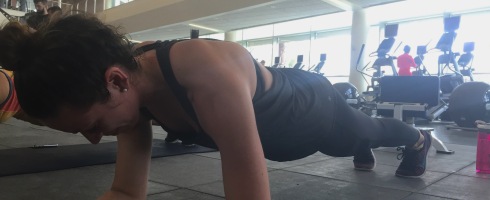
Bailey Garner is a second-year student at the University of Florida studying along the Pre-PA track. She decided to change her major from communications to psychology because of her desire to become a physician assistant. Garner has a huge passion for fitness and nutrition, and she enjoys maintaining a healthy lifestyle and inspiring others to do so. She hopes to one day attend the UF Physician Assistant program.
Editor’s note: This is part of a series of contributing bloggers beginning their careers as journalists/public relations professionals at the University of Florida. Please see my earlier post about getting journalists excited about science writing early on.
By Bailey Garner
Though technology gives people the opportunity to improve their overall health, the rapid advance of this technology could jeopardize that possibility.
With tech gadgets and software constantly evolving, people are continuing to be consumed by the convenience of having everything at the palm of their hand. This convenience could eventually lead to detrimental effects towards people’s health.
In 1990, 11.4 percent of Floridians were obese, according to the State of Obesity website. In just 24 years, that statistic has more than doubled, and though the advancement of technology is not the only factor, it is one of the biggest.
“There are so many different factors that lead to obesity,” said Dr. Karla Pagan Shelnutt, associate professor and extension nutrition specialist at the University of Florida. “The family and home environment is a big one, and if they’re spending a lot of time in front of the screen, they’re not being as active as they should be.”
This is why the general recommendation for children is less than two hours of screen time per day, Shelnutt said.
“There is definitely an association between screen time and food choices and not being active,” said Shelnutt. “It’s like a double whammy when you’re sitting inside and watching TV all day. Not only are these kids not moving, but they’re being exposed to advertisements for unhealthy foods.”
“If they’re on their computer playing a game, there are always advertisements there for unhealthy items.”
When it comes to health, people need to keep in mind that there are multiple aspects including physical, mental, emotional and social, Shelnutt said. With technology continuously becoming a barrier between person-to-person interactions, emotional and social health fall short, she added.
As technology rises, physical health has been put at risk as well. Although many phone applications have been created to promote a healthier lifestyle, people are constantly distracted by the entertainment technology provides.
“I see people at the gym with their phones every day, every hour and every minute,” said Nikko Tan, fitness associate at UF RecSports. “Some people like to use it for music, and other people use their phone for Facebook, Twitter and Instagram in between sets or even when they’re walking from the treadmill to the water fountain.”

Jackie Carranza, first-year UF Pharmacy student, ditches technology during her workout at Southwest Recreation Center on a Saturday morning. Carranza says she tries to stay away from her phone while at the gym so she can have effective workouts. Photo by Bailey Garner.
Students even go to the extent of taking pictures of themselves while working out, Tan said.
“You have a rest period, you don’t really know what you’re doing, you don’t want to seem awkward and just stand there so the easiest thing for people to do is go on their phone,” said Hakeem White, CEO and founder of fitness and nutrition company, Hakeem Getz You Gainz.
Being thoroughly dedicated to his health and well being, White is able to see the negatives and positives of technology.
“It’s a 50-50 honestly,” said White, who is also a nutrition major at UF and a UF RecSports personal trainer. “You have apps nowadays and programs that can help you track what you eat and can help you with your workout or show you proper form.”
However, there is also an overabundance of social media that can distract people who are working towards their fitness goals, White said.
One glance at a college campus can give anyone an idea of what the future of technology may be like. With fancy gadgets emerging such as the hover board, even walking may eventually become a thing of the past.
“Society as a whole is losing traction on their health and their fitness, and that’s definitely in decline,” said White. “At the rate we’re going, technology is just making life a lot easier.”
However, technology continues to give people the opportunity to lead a healthy lifestyle. Shelnutt uses her Fitbit to track her steps as she participates in the Walk Challenge at UF, Shelnutt said. Tan has recorded over 600 miles on his Nike+ Running app, Tan said. White continues to track his food intake and how effective his workouts are through his use of technology, White said.
“I think if we don’t get a grasp on how we use technology, it can get out of hand,” White said. “But if you use the aspects of technology that are around properly to aid in your fitness, it can be very beneficial.”













